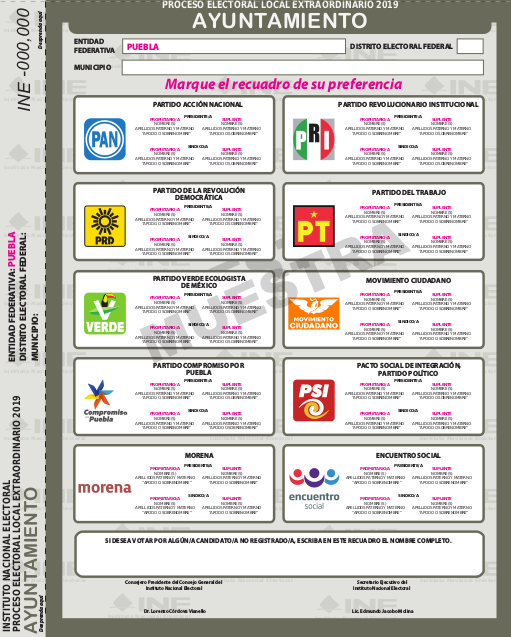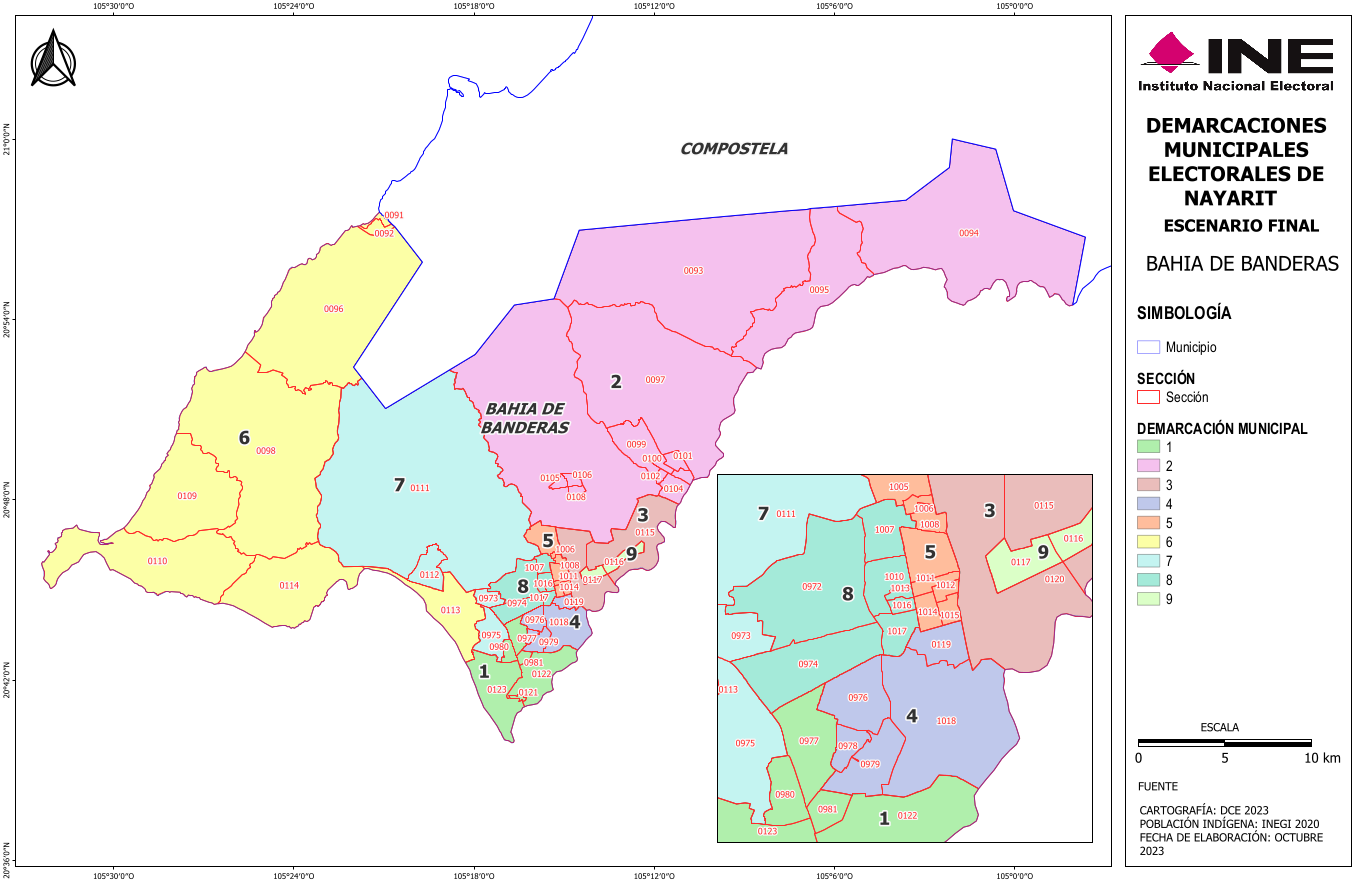Institutions and municipal policy
Thirty Mexican states elect municipal officers with a fused ballot. Just two do not. But they open room to study electoral system effects in policy.
Mexico has almost 2,500 municipios across 32 states. Municipal governments, called ayuntamientos, each have a president who is executive officer, a síndico or financial officer (large municipios in some states have more than one) and a cabildo, a council whose members, called regidores, deliberate and vote policy. To illustrate the modal ayuntamiento election rule, we travel back in time to the year 1997, when nowaday's tiny institutional variance was non-existant. Voters of every elected1 ayuntamiento had a single vote and voted for a fused president–síndico–cabildo list ticket. Fig 1 shows a fused (present-day) ballot specimen, the president and síndico candidates in the front, the closed-list council member candidates in the back. Fused ballots cannot be split. The most voted-for ticket won the municipal president, the sindico and a fraction (variable across states) of regidores.2
 |
 |
The first exception to this rigid voting method came in 1998, when reformers in Chihuahua made the síndico a separate elected office in the state's 67 municipal governments. Voters since get a second vote to elect their municipal síndico by plurality in the municipality at large, concurrent with the rest of the ayuntamiento. Chihuahuan síndico vote returns since 1998 are available here. As the table below summarizes, lists topping the ayuntamiento vote mostly won the síndico races too. Yet, on average, one in five municipalities had split outcomes, reaching one in three in the year 2018. And parties winning the municipal presidency and most regidores systematically sufferend a drop in the vote share for its síndico candidate, revealing some propensity towards ticket splitting.
| Column A | Column B | |
|---|---|---|
| Year | % split mun. | Vote share dif. |
| 1998 | 12% | +2.2% |
| 2001 | 16% | +1.7% |
| 2004 | 27% | +2.3% |
| 2007 | 13% | +3.1% |
| 2010 | 21% | +3.9% |
| 2013 | 18% | +3.3% |
| 2016 | 27% | +1.6% |
| 2018 | 33% | +4.5% |
| 2021 | 19% | +5.1% |
Then came Nayarit in 2008. Nayarita voters since then have two votes as well, one for a fused president–síndico ticket, another to elect a fraction of council regidores in single-member plurality districts (called demarcaciones). Figure 1 is a map of one Nayarita municipality's demarcaciones. Each geographic unit returns one regidor to the municipal council. The remainder regidores are allocated by proportional representation. Demarcación vote returns are available here and here. Nayarit reformers were more ambitious than Chihuahua's, creating territorial representation in the cabildo. A plurality of voters concentrated in a densely populated area may suffice for winning the municipal presidency–síndico, but winning a municipal council majority may also require winning voters spread across the municipio's territory.

Figure 1: Bahía de Banderas, Nayarit municipality's nine demarcaciones (from https://ieenayarit.org/geografia)
Institutions are one important determinant of political outcomes by setting up incentives for candidates and municipal officers. Ambitious politicians vie to occupate municipal offices and their policy making powers, and electoral rules favor strategies to compete for the popular vote (Myerson 1995). While still limited (see the table below), slight institutional variance has slowly creeped in, an opportunity to shed some light on Mexican municipal governments with cross-sectional and cross-temporal studies of policy.
| Election rule | N | % |
|---|---|---|
| Fused ballots | 1,962 | 79 |
| Síndico elected separately | 67 | 3 |
| Regidores elected in SMDs | 18 | 1 |
| Unelected usos y costumbres | 423 | 17 |
| Total municipalities | 2,470 | 100 |
1 References
Elizarrarás, Rodrigo. 2002. Gobernabilidad y autonomía indígena: motivos y efectos en el reconocimiento de los usos y costumbres en Oaxaca. BA thesis, ITAM.
Myerson, Roger B. 1995. Analysis of Democratic Institutions: Structure, Conduct, and Performance. Journal of Economic Perspectives 9(1):77–89.
Footnotes:
In 1995, Oaxaca legislated Usos y costumbres municipalities. These opted out of the electoral process, appointing municipal officers with "traditional" methods. See Elizarrarás 2002. Of 570 municipalities in the state, 418 (mostly with a native American majority) migrated to usos y costumbres. The remaining 152 retained elections, and one more moved out of, then back into the election track. Since, one municipality is Chiapas, one in Michoacán, and three in Morelos adopted usos y costumbres.
States granting large municipalities multiple sindicos, such as the State of Mexico, also distribute a share with proportional representation.

Comentar